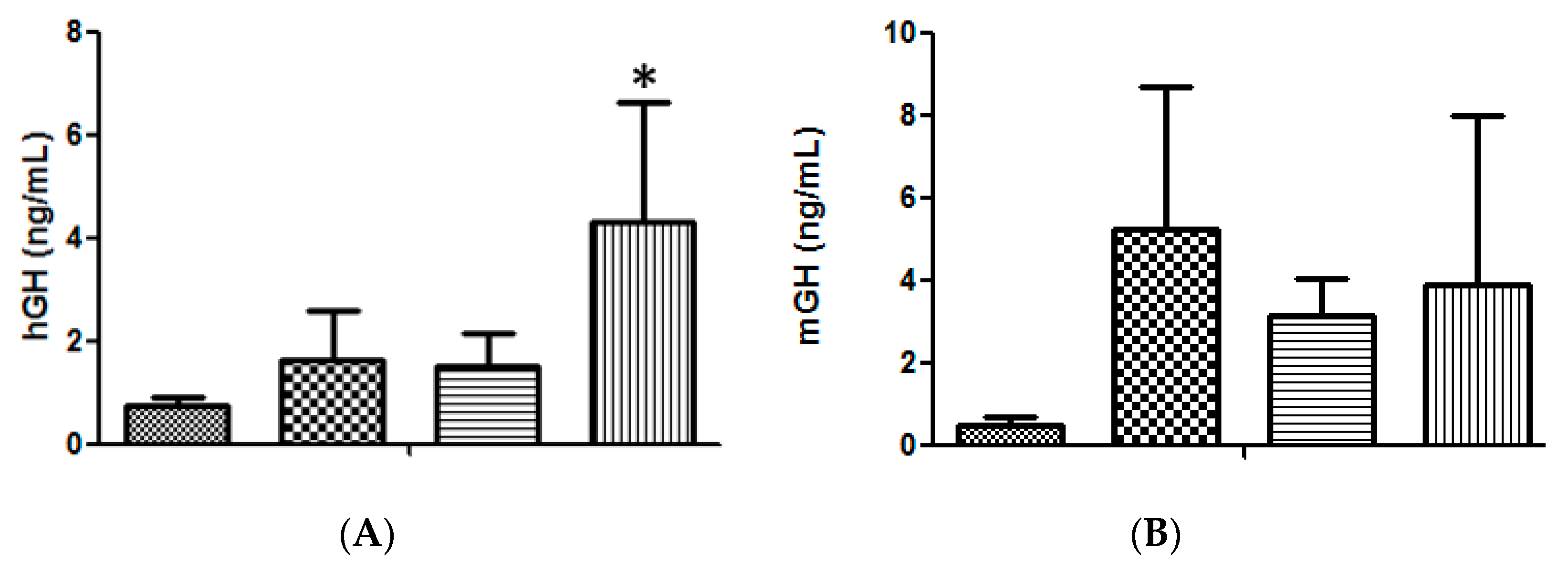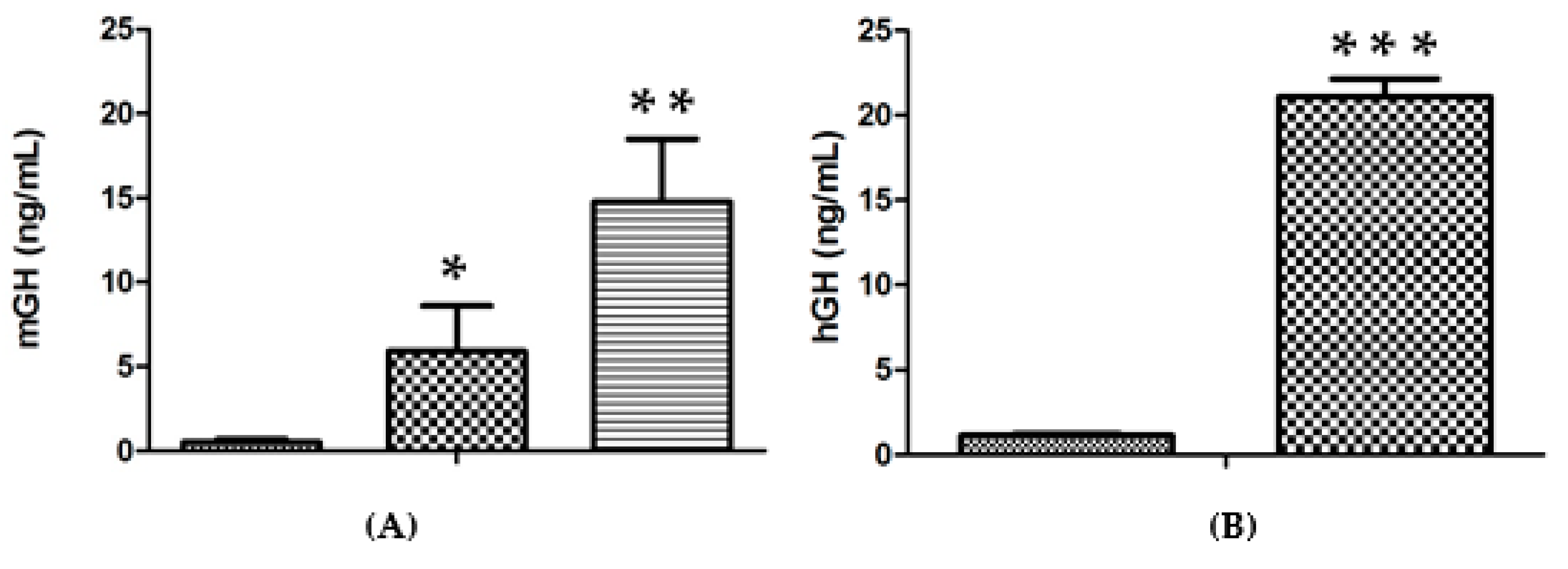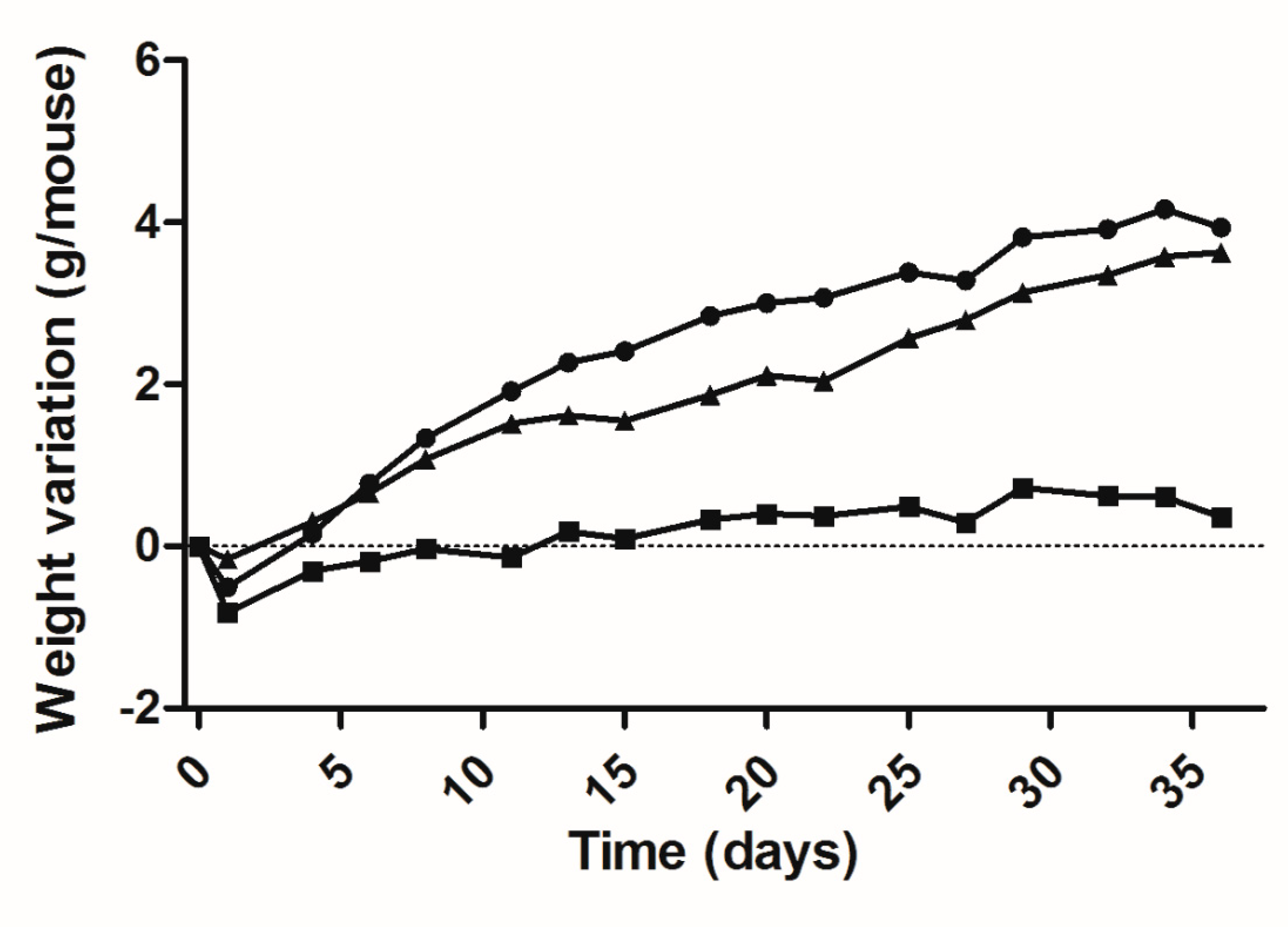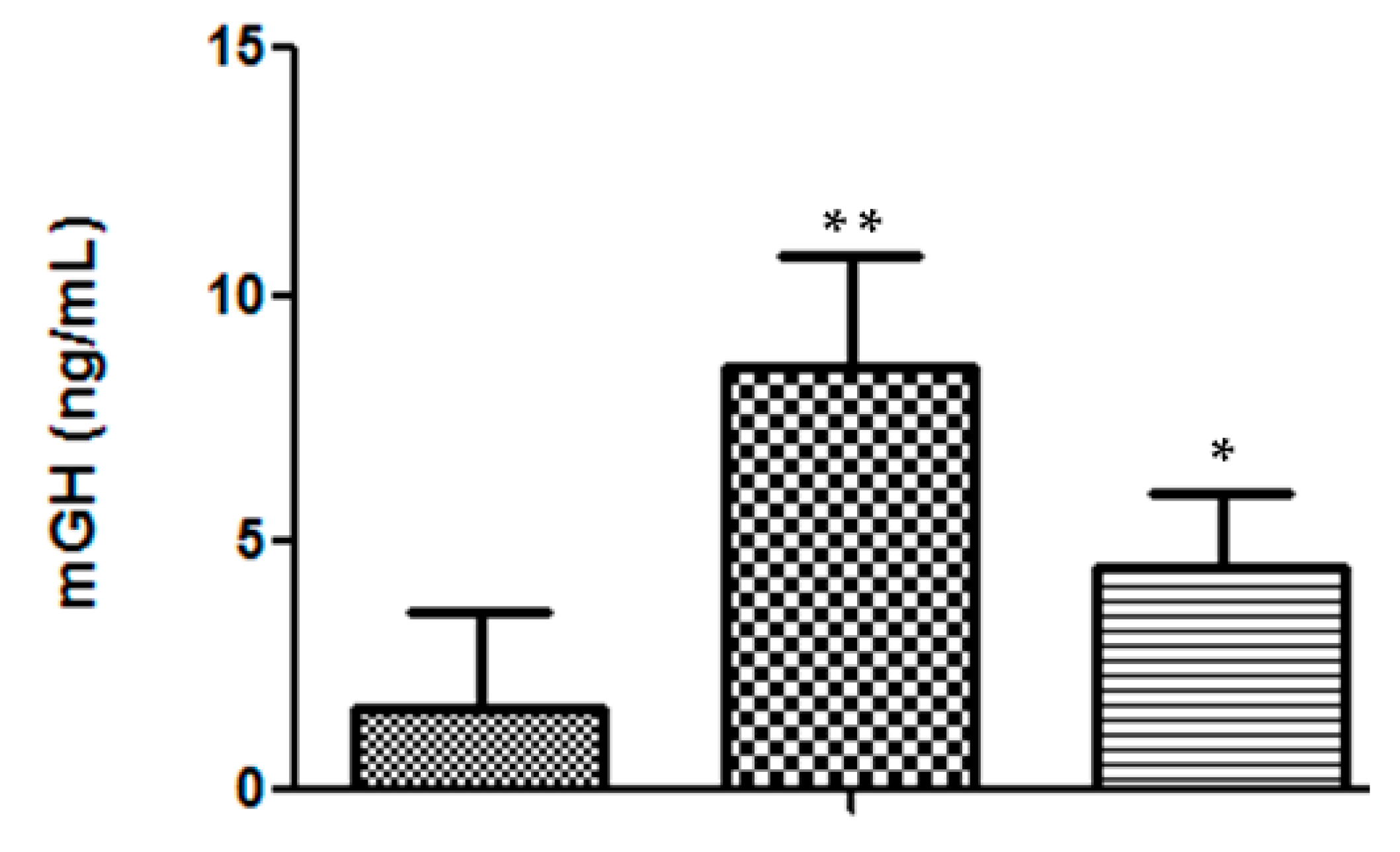Optimization of Mouse Growth Hormone Plasmid DNA Electrotransfer into Tibialis Cranialis Muscle of “Little” Mice
Abstract
1. Introduction
2. Results
3. Discussion
4. Materials and Methods
4.1. Animals
4.2. Plasmids
4.3. Plasmids Administration and Electroporation
4.4. Bioassay
4.5. Radiographic Measurements
4.6. Catch-Up Growth Calculation
4.7. Statistical Analyses
5. Conclusions
Author Contributions
Funding
Conflicts of Interest
Abbreviations
| hGH | human growth hormone |
| mGH | mouse growth hormone |
| mIGF-1 | mouse insulin like growth factor-1 |
References
- Ginn, S.L.; Amaya, A.K.; Alexander, I.E.; Edelstein, M.; Abedi, M.R. Gene therapy trials worldwide to 2017: An update. J. Gene Med. 2018, 20, e3015. [Google Scholar] [CrossRef] [PubMed]
- Wang, W.; Wenzhong, L.; Ma, N.; Steinhoff, G. Non-viral gene delivery methods. Curr. Pharm. Biotechnol. 2013, 14, 46–60. [Google Scholar]
- Zhang, L.; Nolan, E.; Kreitschitz, S.; Rabussay, D.P. Enhanced delivery of naked DNA to the skin by non-invasive in vivo electroporation. Biochim. Biophys. Acta 2002, 1572, 1–9. [Google Scholar] [CrossRef]
- Oliveira, N.A.J.; Cecchi, C.R.; Higuti, E.; Oliveira, J.E.; Jensen, T.G.; Bartolini, P.; Peroni, C.N. Long-term human growth hormone expression and partial phenotypic correction by plasmid-based gene therapy in an animal model of isolated growth hormone deficiency. J. Gene Med. 2010, 12, 580–585. [Google Scholar] [CrossRef] [PubMed]
- Higuti, E.; Cecchi, C.R.; Oliveira, N.A.; Lima, E.R.; Vieira, D.P.; Aagaard, L.; Jensen, T.G.; Jorge, A.A.; Bartolini, P.; Peroni, C.N. Partial correction of the dwarf phenotype by non-viral transfer of the growth hormone gene in mice: Treatment age is critical. Curr. Gene Ther. 2016, 26, 1–7. [Google Scholar] [CrossRef] [PubMed]
- Shi, J.; Ma, Y.; Zhu, J.; Chen, Y.; Sun, Y.; Yao, Y.; Yang, Z.; Xie, J. A review on electroporation-based intracellular delivery. Molecules 2018, 23, 3044. [Google Scholar] [CrossRef]
- Daud, A.I.; DeConti, R.C.; Andrews, S.; Urbas, P.; Riker, A.I.; Sondak, V.K.; Munster, P.N.; Sullivan, D.M.; Ugen, K.E.; Messina, J.L.; et al. Phase I trial of interleukin-12 plasmid electroporation in patients with metastatic cancer. J. Clin. Oncol. 2008, 26, 5896–5903. [Google Scholar] [CrossRef]
- Cervia, L.D.; Yuan, F. Current progress in electrotransfection as a nonviral method for gene delivery. Mol. Pharm. 2018, 15, 3617–3624. [Google Scholar] [CrossRef]
- Higuti, E.; Cecchi, C.R.; Oliveira, N.A.J.; Vieira, D.P.; Jensen, T.G.; Jorge, A.A.L.; Bartolini, P.; Peroni, C.N. Growth responses following a single intra-muscular hGH plasmid administration compared to daily injections of hGH in dwarf mice. Curr. Gene Ther. 2012, 12, 437–443. [Google Scholar] [CrossRef]
- Cecchi, C.R.; Higuti, E.; Oliveira, N.A.J.; Lima, E.R.; Jacobsen, M.; Dagnaes-Hansen, F.; Aagaard, L.; Jorge, A.A.L.; Jensen, T.G.; Bartolini, P.; et al. A novel homologous model for gene therapy of dwarfism by non-viral transfer of the mouse growth hormone gene into immunocompetent dwarf mice. Curr. Gene Ther. 2014, 14, 44–51. [Google Scholar] [CrossRef]
- Cecchi, C.R.; Higuti, E.; Lima, E.R.; Vieira, D.P.; Squair, P.L.; Peroni, C.N.; Bartolini, P. Efficient non-invasive plasmid-DNA administration into tibialis cranialis muscle of “little” mice. Curr. Mol. Med. 2017, 17, 230–235. [Google Scholar] [CrossRef] [PubMed]
- Cattini, P.A.; Bock, M.E.; Jin, Y.; Zanghi, J.A.; Vakili, H. A useful model to compare human and mouse growth hormone gene chromosomal structure, expression and regulation, and immune tolerance of human growth hormone analogues. Growth Horm. IGF Res. 2018, 42–43, 58–65. [Google Scholar] [CrossRef] [PubMed]
- Hojman, P.; Gissel, H.; Gehl, J. Sensitive and precise regulation of haemoglobin after gene transfer of erythropoietin to muscle tissue using electroporation. Gene Ther. 2007, 14, 950–959. [Google Scholar] [CrossRef] [PubMed][Green Version]
- Fewell, J.G.; MacLaughlin, F.; Mehta, V.; Gondo, M.; Nicol, F.; Wilson, E.; Smith, L.C. Gene therapy for the treatment of hemophilia B using pinc-formulated plasmid delivered to muscle with electroporation. Mol. Ther. 2001, 3, 574–583. [Google Scholar] [CrossRef] [PubMed]
- Nicol, F.; Wong, M.; MacLaughlin, F.C.; Perrard, J.; Nordstrom, J.L.; Smith, L.C. Poly-L-glutamate, an anionic polymer, enhances transgene expression for plasmids delivered by intramuscular injection with in vivo electroporation. Gene Ther. 2002, 9, 1351–1358. [Google Scholar] [CrossRef] [PubMed]
- Wang, X.; Tang, J.; Xie, X.; Yang, J.; Li, S.; Ji, J.; Gu, J. A comprehensive study of optimal conditions for naked plasmid DNA transfer into skeletal muscle by electroporation. J. Gene Med. 2005, 7, 1235–1245. [Google Scholar] [CrossRef]
- Bielohuby, M.; Schaab, M.; Kummann, M.; Sawitzky, M.; Gebhardt, R.; Binder, G.; Frystyk, J.; Bjerre, M.; Hoeflich, A.; Kratzsch, J.; et al. Serum IGF-I is not a reliable pharmacodynamics marker of exogenous growth hormone activity in mice. Endocrinology 2011, 152, 4764–4776. [Google Scholar] [CrossRef]
- Yakar, S.; Rosen, C.J.; Beamer, W.G.; Ackert-Bicknell, C.L.; Wu, Y.P.; Liu, J.L.; Ooi, G.T.; Setser, J.; Frystyk, J.; Boisclair, Y.R.; et al. Circulating levels of IGF-1 directly regulate bone growth and density. J. Clin. Investig. 2002, 110, 771–781. [Google Scholar] [CrossRef]
- Donahue, L.R.; Beamer, W.G. Growth hormone deficiency in “little” mice results in aberrant body composition, reduced insulin-like growth factor-I and insulin-like growth factor-binding protein-3 (IGFBP-3), but does not affect IGFBP-2, -1 or -4. J. Endocrinol. 1993, 136, 91–104. [Google Scholar] [CrossRef]
- Deitel, K.; Dantzer, D.; Ferguson, P.; Pollak, M.; Beamer, W.G.; Andrulis, I.; Bell, R. Reduced growth of human sarcoma xenografts in hosts homozygous for the lit mutation. J. Surg. Oncol. 2002, 81, 75–79. [Google Scholar] [CrossRef]
- Bellini, M.H.; Bartolini, P. In vivo bioassay for the potency determination of human growth hormone in dwarf “little” mice. Endocrinology 1993, 132, 2051–2055. [Google Scholar] [CrossRef] [PubMed]
- Bellini, M.H.; Peroni, C.N.; Bartolini, P. Increases in weight of growth hormone-deficient and immunodeficient (lit/scid) dwarf mice after grafting of hGH-secreting, primary human keratinocytes. FASEB J. 2003, 17, 2322–2324. [Google Scholar] [CrossRef] [PubMed]
- Dagnaes-Hansen, F.; Holst, H.U.; Sondergaard, M.; Vorup-Jensen, T.; Flyvbjerg, A.; Jensen, U.B.; Jensen, T.J. Physiological effects of human growth hormone produced after hydrodynamic gene transfer of a plasmid vector containing the human ubiquitin promotor. J. Mol. Med. 2002, 80, 665–670. [Google Scholar] [CrossRef] [PubMed]
 ) negative control (20 μL saline); (
) negative control (20 μL saline); ( ) 50 μg DNA in 10 μL applying the 375 V/cm protocol; (
) 50 μg DNA in 10 μL applying the 375 V/cm protocol; ( ) 50 μg DNA in 20 μL applying the HV/LV protocol; (
) 50 μg DNA in 20 μL applying the HV/LV protocol; ( ) 50 μg DNA in 20 μL, applying the 375 V/cm protocol. (n = 6 animals per condition); significance test, in comparison with the negative control: * p < 0.02. (B). Serum mGH concentration in lit/lit mice, 3 days after a single administration into the right TA muscle of different amounts of mGH plasmid DNA dissolved in 20 μL of saline, followed by the 375 V/cm electrotransference protocol: (
) 50 μg DNA in 20 μL, applying the 375 V/cm protocol. (n = 6 animals per condition); significance test, in comparison with the negative control: * p < 0.02. (B). Serum mGH concentration in lit/lit mice, 3 days after a single administration into the right TA muscle of different amounts of mGH plasmid DNA dissolved in 20 μL of saline, followed by the 375 V/cm electrotransference protocol: ( ) negative control (saline); (
) negative control (saline); ( ) 50 μg DNA; (
) 50 μg DNA; ( ) 75 μg DNA; (
) 75 μg DNA; ( ) 100 μg DNA. (n = 3 animals per condition).
) 100 μg DNA. (n = 3 animals per condition).
 ) negative control (20 μL saline); (
) negative control (20 μL saline); ( ) 50 μg DNA in 10 μL applying the 375 V/cm protocol; (
) 50 μg DNA in 10 μL applying the 375 V/cm protocol; ( ) 50 μg DNA in 20 μL applying the HV/LV protocol; (
) 50 μg DNA in 20 μL applying the HV/LV protocol; ( ) 50 μg DNA in 20 μL, applying the 375 V/cm protocol. (n = 6 animals per condition); significance test, in comparison with the negative control: * p < 0.02. (B). Serum mGH concentration in lit/lit mice, 3 days after a single administration into the right TA muscle of different amounts of mGH plasmid DNA dissolved in 20 μL of saline, followed by the 375 V/cm electrotransference protocol: (
) 50 μg DNA in 20 μL, applying the 375 V/cm protocol. (n = 6 animals per condition); significance test, in comparison with the negative control: * p < 0.02. (B). Serum mGH concentration in lit/lit mice, 3 days after a single administration into the right TA muscle of different amounts of mGH plasmid DNA dissolved in 20 μL of saline, followed by the 375 V/cm electrotransference protocol: ( ) negative control (saline); (
) negative control (saline); ( ) 50 μg DNA; (
) 50 μg DNA; ( ) 75 μg DNA; (
) 75 μg DNA; ( ) 100 μg DNA. (n = 3 animals per condition).
) 100 μg DNA. (n = 3 animals per condition).
 ) Negative control (saline); (
) Negative control (saline); ( ) two injections into one TA muscle; (
) two injections into one TA muscle; ( ) 2 injections into each TA muscle (n = 3 animals per condition). (B). Serum hGH concentrations in lit/scid mice, 3 days after administration of 50 μg hGH plasmid DNA per injection (20 μL) in the TA muscle followed by electrotransfer based on the 375 V/cm protocol: (
) 2 injections into each TA muscle (n = 3 animals per condition). (B). Serum hGH concentrations in lit/scid mice, 3 days after administration of 50 μg hGH plasmid DNA per injection (20 μL) in the TA muscle followed by electrotransfer based on the 375 V/cm protocol: ( ) negative control (saline); (
) negative control (saline); ( ) 2 injections into each TA muscle (n = 7 animals per condition). Significance test, in comparison with the negative control: * p < 0.05; ** p < 0.005; *** p < 0.001.
) 2 injections into each TA muscle (n = 7 animals per condition). Significance test, in comparison with the negative control: * p < 0.05; ** p < 0.005; *** p < 0.001.
 ) Negative control (saline); (
) Negative control (saline); ( ) two injections into one TA muscle; (
) two injections into one TA muscle; ( ) 2 injections into each TA muscle (n = 3 animals per condition). (B). Serum hGH concentrations in lit/scid mice, 3 days after administration of 50 μg hGH plasmid DNA per injection (20 μL) in the TA muscle followed by electrotransfer based on the 375 V/cm protocol: (
) 2 injections into each TA muscle (n = 3 animals per condition). (B). Serum hGH concentrations in lit/scid mice, 3 days after administration of 50 μg hGH plasmid DNA per injection (20 μL) in the TA muscle followed by electrotransfer based on the 375 V/cm protocol: ( ) negative control (saline); (
) negative control (saline); ( ) 2 injections into each TA muscle (n = 7 animals per condition). Significance test, in comparison with the negative control: * p < 0.05; ** p < 0.005; *** p < 0.001.
) 2 injections into each TA muscle (n = 7 animals per condition). Significance test, in comparison with the negative control: * p < 0.05; ** p < 0.005; *** p < 0.001.
 ) negative control (saline), n = 5 mice: Y = −0.4322 + 0.0451X − 0.0004·10−3X2 (DF = 15; R2 = 0.7940); (
) negative control (saline), n = 5 mice: Y = −0.4322 + 0.0451X − 0.0004·10−3X2 (DF = 15; R2 = 0.7940); ( ) DNA-treated mice, n = 7: Y = −0.3897 + 0.2256X − 0.0028·10−3X2 (DF = 15; R2 = 0.9808); (
) DNA-treated mice, n = 7: Y = −0.3897 + 0.2256X − 0.0028·10−3X2 (DF = 15; R2 = 0.9808); ( ) normal (heterozygous) mice, n = 4: Y = −0.0535 + 0.1195X − 0.0004·10−3X2 (DF = 15; R2 = 0.9810).
) normal (heterozygous) mice, n = 4: Y = −0.0535 + 0.1195X − 0.0004·10−3X2 (DF = 15; R2 = 0.9810).
 ) negative control (saline), n = 5 mice: Y = −0.4322 + 0.0451X − 0.0004·10−3X2 (DF = 15; R2 = 0.7940); (
) negative control (saline), n = 5 mice: Y = −0.4322 + 0.0451X − 0.0004·10−3X2 (DF = 15; R2 = 0.7940); ( ) DNA-treated mice, n = 7: Y = −0.3897 + 0.2256X − 0.0028·10−3X2 (DF = 15; R2 = 0.9808); (
) DNA-treated mice, n = 7: Y = −0.3897 + 0.2256X − 0.0028·10−3X2 (DF = 15; R2 = 0.9808); ( ) normal (heterozygous) mice, n = 4: Y = −0.0535 + 0.1195X − 0.0004·10−3X2 (DF = 15; R2 = 0.9810).
) normal (heterozygous) mice, n = 4: Y = −0.0535 + 0.1195X − 0.0004·10−3X2 (DF = 15; R2 = 0.9810).
 ) saline, n = 5 mice; (
) saline, n = 5 mice; ( ) DNA-treated mice, n = 7; (
) DNA-treated mice, n = 7; ( ) heterozygous mice, n = 4. Significance test, in comparison with the negative control: * p < 0.05; ** p < 0.001.
) heterozygous mice, n = 4. Significance test, in comparison with the negative control: * p < 0.05; ** p < 0.001.
 ) saline, n = 5 mice; (
) saline, n = 5 mice; ( ) DNA-treated mice, n = 7; (
) DNA-treated mice, n = 7; ( ) heterozygous mice, n = 4. Significance test, in comparison with the negative control: * p < 0.05; ** p < 0.001.
) heterozygous mice, n = 4. Significance test, in comparison with the negative control: * p < 0.05; ** p < 0.001.
| Growth Parameter | Before Treatment (mean ± SD) | After Treatment (mean ± SD) | Increase (%) * 1 | Significance Level * 1 | Catch-Up Growth (%) |
|---|---|---|---|---|---|
| Body weight (g) | |||||
| DNA-treated | 10.63 ± 0.96 | 14.81 ± 1.25 | 39.3 | p < 0.001 | 40.9 |
| heterozygous | 16.64 ± 1.82 | 20.22 ± 1.94 | 21.5 | p < 0.05 | |
| saline | 10.46 ± 0.55 | 11.07 ± 0.76 | 5.8 | n.s. * 2 | |
| Nose-to-tail length (cm) | |||||
| DNA-treated | 13.19 ± 0.45 | 14.54 ± 0.50 | 10.2 | p < 0.002 | 38.2 |
| heterozygous | 14.55 ± 0.39 | 15.80 ± 0.74 | 8.6 | p < 0.02 | |
| saline | 13.18 ± 0.36 | 13.76 ± 0.24 | 4.4 | p < 0.02 | |
| Right femur length (mm) | |||||
| DNA-treated | 9.4 ± 0.03 | 12.50 ± 0.05 | 32.9 | p < 0.002 | 82.6 |
| heterozygous | 10.8 ± 0.09 | 12.90 ± 0.11 | 19.4 | p < 0.02 | |
| saline | 10.0 ± 0.05 | 10.6 ± 0.04 | 6.0 | n.s. | |
| Left femur length (mm) | |||||
| DNA-treated | 10.0 ± 0.08 | 12.40 ± 0.06 | 24.0 | p < 0.002 | 76.9 |
| heterozygous | 11.1 ± 0.07 | 13.00 ± 0.12 | 17.1 | p < 0.05 | |
| saline | 10.1 ± 0.07 | 10.40 ± 0.04 | 2.9 | n.s. |
| Animal Group | n | After Treatment (mean ± SD) | Difference (%) * 1 | Significance Level * 1 | Catch-Up (%) |
|---|---|---|---|---|---|
| DNA-treated | 7 | 71.2 ± 16.9 | 49.2 | n.s. * 2 | 8.5 |
| heterozygous | 4 | 325.0 ± 142.0 | 581.3 | p < 0.005 | |
| saline | 5 | 47.7 ± 33.5 | - | - |
Sample Availability: Samples of the compounds are not available from the authors. | |
Publisher’s Note: MDPI stays neutral with regard to jurisdictional claims in published maps and institutional affiliations. |
© 2020 by the authors. Licensee MDPI, Basel, Switzerland. This article is an open access article distributed under the terms and conditions of the Creative Commons Attribution (CC BY) license (http://creativecommons.org/licenses/by/4.0/).
Share and Cite
Rosa Lima, E.; Regina Cecchi, C.; Higuti, E.; Protasio Pacheco de Jesus, G.; Moura Gomes, A.; Aparecido Zacarias, E.; Bartolini, P.; Nunes Peroni, C. Optimization of Mouse Growth Hormone Plasmid DNA Electrotransfer into Tibialis Cranialis Muscle of “Little” Mice. Molecules 2020, 25, 5034. https://doi.org/10.3390/molecules25215034
Rosa Lima E, Regina Cecchi C, Higuti E, Protasio Pacheco de Jesus G, Moura Gomes A, Aparecido Zacarias E, Bartolini P, Nunes Peroni C. Optimization of Mouse Growth Hormone Plasmid DNA Electrotransfer into Tibialis Cranialis Muscle of “Little” Mice. Molecules. 2020; 25(21):5034. https://doi.org/10.3390/molecules25215034
Chicago/Turabian StyleRosa Lima, Eliana, Claudia Regina Cecchi, Eliza Higuti, Gustavo Protasio Pacheco de Jesus, Alissandra Moura Gomes, Enio Aparecido Zacarias, Paolo Bartolini, and Cibele Nunes Peroni. 2020. "Optimization of Mouse Growth Hormone Plasmid DNA Electrotransfer into Tibialis Cranialis Muscle of “Little” Mice" Molecules 25, no. 21: 5034. https://doi.org/10.3390/molecules25215034
APA StyleRosa Lima, E., Regina Cecchi, C., Higuti, E., Protasio Pacheco de Jesus, G., Moura Gomes, A., Aparecido Zacarias, E., Bartolini, P., & Nunes Peroni, C. (2020). Optimization of Mouse Growth Hormone Plasmid DNA Electrotransfer into Tibialis Cranialis Muscle of “Little” Mice. Molecules, 25(21), 5034. https://doi.org/10.3390/molecules25215034





